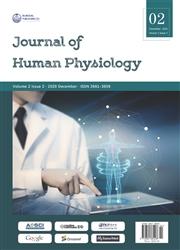Acute Effect of Kapalbhati Yoga on Cardiac Autonomic Control Using Heart Rate Variability Analysis in Healthy Male Individuals
引用次数: 2
Abstract
Kapalbhati is well known for improving cardiovascular health. But there are some reports of heart attacks while practising kapalbhati. We hypothesize that ill-effect of kapalbhati could be because of autonomic dysfunction to heart. In the present study, we aim to understand the acute effect of kapalbhati yoga on heart rate dynamics using heart rate variability (HRV) analysis. Resting heart rate (HR) varies widely in different individuals and during various physiological stresses, particularly, exercise it can go up to three-fold. These changes in heart rate are known as heart rate variability (HRV). Variability in heart rate reflects the control of autonomic system on the heart and which can be determined during brief periods of electrocardiographic (ECG) monitoring. HRV measures the effect of any physical exercise on the heart rate using time- and frequency-domain methods. Frequency-domain method involves power spectral analyses of the beat-to-beat intervals (R-R intervals) variability data. When total power vs. frequency, fast fourier transform analysis of R-R intervals data is done, it shows three well-defined peaks/rhythms in every individual, which contain different physiological information. Thus, the total spectral power of R-R intervals data can be divided into three components or bands viz., the very low frequency (VLF) band, the low-frequency (LF) band and the high frequency (HF) band. VLF represent very long time-period physiological phenomenon like thermoregulation, circadian rhythms etc. and thus are not seen in short-term recordings like in this work. LF band power represents long period physiological rhythms in the frequency range of 0.05- 0.15 Hz and LF band power increases as a consequence of sympathetic activation. HF band represent physiological rhythms in the frequency range of 0.15-0.5 Hz and they are synchronous with the respiration rate, and arise due to the intrathoracic pressure changes and mechanical vibrations caused by the breathing activity. In this work, twenty healthy male volunteers were trained in kapalbhati yoga and their ECG waveforms (2 min.) were obtained while doing kapalbhati (breathing at 1 Hz frequency for 2 min.) and were compared with the baseline (just 2 min. before the start) and post-kapalbhati (immediately 2 min. after completing the practice) HRV data. Our results showed a significant decrease in the time-domain measures i.e., NN50, pNN50 and the mean heart rate interval during-kapalbhati when compared statistically to the respective before practice or “pre”-kapalbhati (p < 0.05, student’s paired t-test) values. Frequency-domain indices showed that during-kapalbhati there is a significant increase (~48%) in the LF band power which suggests sympathetic activation and a significant increase (~88%) in the low frequency to the high frequency power ratio (LF/HF ratio) which indicates sympathetic system predominance. A significant decrease (~63%) in the HF component was also noted during-kapalbhati as compared to the “pre-kapalbhati” values which shows decrease in parasympathetic tone. Thus, these results suggest that during-kapalbhati there is drastic increase of sympathetic tone whereas parasympathetic activity is reduced. We propose these changes in autonomic system control on heart are responsible for the myocardial ischemic attacks induced during kapalbhati in some individuals.Kapalbhati瑜伽对健康男性心脏自主控制的急性影响
Kapalbhati以改善心血管健康而闻名。但也有一些关于练习卡巴哈提时心脏病发作的报道。我们推测卡巴他提的不良作用可能是由于心脏自主神经功能障碍。在本研究中,我们旨在通过心率变异性(HRV)分析来了解kapalbhati瑜伽对心率动力学的急性影响。不同个体的静息心率(HR)差异很大,在各种生理压力下,尤其是在运动中,它可能高达三倍。这些心率变化被称为心率变异性(HRV)。心率的可变性反映了自主神经系统对心脏的控制,并且可以在短暂的心电图(ECG)监测期间确定。HRV使用时域和频域方法测量任何体育锻炼对心率的影响。频域方法涉及对差拍间隔(R-R间隔)变异性数据的功率谱分析。当对R-R间期数据进行总功率与频率的快速傅立叶变换分析时,它显示了每个个体中三个定义明确的峰值/节律,其中包含不同的生理信息。因此,R-R区间数据的总频谱功率可以分为三个分量或频带,即极低频(VLF)频带、低频(LF)频带和高频(HF)频带。VLF代表了很长一段时间的生理现象,如体温调节、昼夜节律等,因此在这项工作中的短期记录中看不到。低频带功率代表0.05-0.15Hz频率范围内的长周期生理节律,低频带功率由于交感神经激活而增加。HF波段代表0.15-0.5Hz频率范围内的生理节律,它们与呼吸频率同步,并由于呼吸活动引起的胸腔内压力变化和机械振动而出现。在这项工作中,20名健康男性志愿者接受了kapalbhati瑜伽训练,并在进行Kapalbhatti(以1Hz频率呼吸2分钟)时获得了他们的心电图波形(2分钟),并与基线(开始前2分钟)和Kapalbhatit后(完成练习后2分钟)的HRV数据进行了比较。我们的结果显示,与练习前或“前”kapalhati(p<0.05,学生配对t检验)值相比,kapalbati期间的时域测量值(即NN50、pNN50和平均心率间隔)在统计学上显著降低。频域指标显示,在kapalbhati期间,低频带功率显著增加(~48%),表明交感神经激活,低频与高频功率比(LF/HF比)显著增加(~88%),表示交感神经系统占优势。与显示副交感神经张力降低的“kapalbhati前”值相比,kapalbhathi期间HF成分也显著降低(~63%)。因此,这些结果表明,在kapalbhati期间,交感神经张力急剧增加,而副交感神经活动减少。我们认为,心脏自主神经系统控制的这些变化是一些人在kapalbhati期间诱发心肌缺血发作的原因。
本文章由计算机程序翻译,如有差异,请以英文原文为准。
求助全文
约1分钟内获得全文
求助全文

 求助内容:
求助内容: 应助结果提醒方式:
应助结果提醒方式:


